File Info
| Exam | VMware vSphere 8-x Advanced Design |
| Number | 3V0-21.23 |
| File Name | VMware.3V0-21.23.VCEplus.2025-02-21.24q.tqb |
| Size | 158 KB |
| Posted | Feb 21, 2025 |
| Download | VMware.3V0-21.23.VCEplus.2025-02-21.24q.tqb |
How to open VCEX & EXAM Files?
Files with VCEX & EXAM extensions can be opened by ProfExam Simulator.
Coupon: MASTEREXAM
With discount: 20%
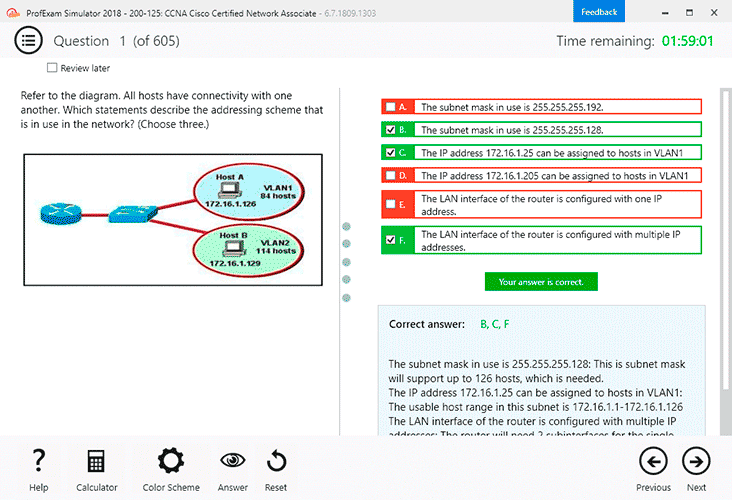
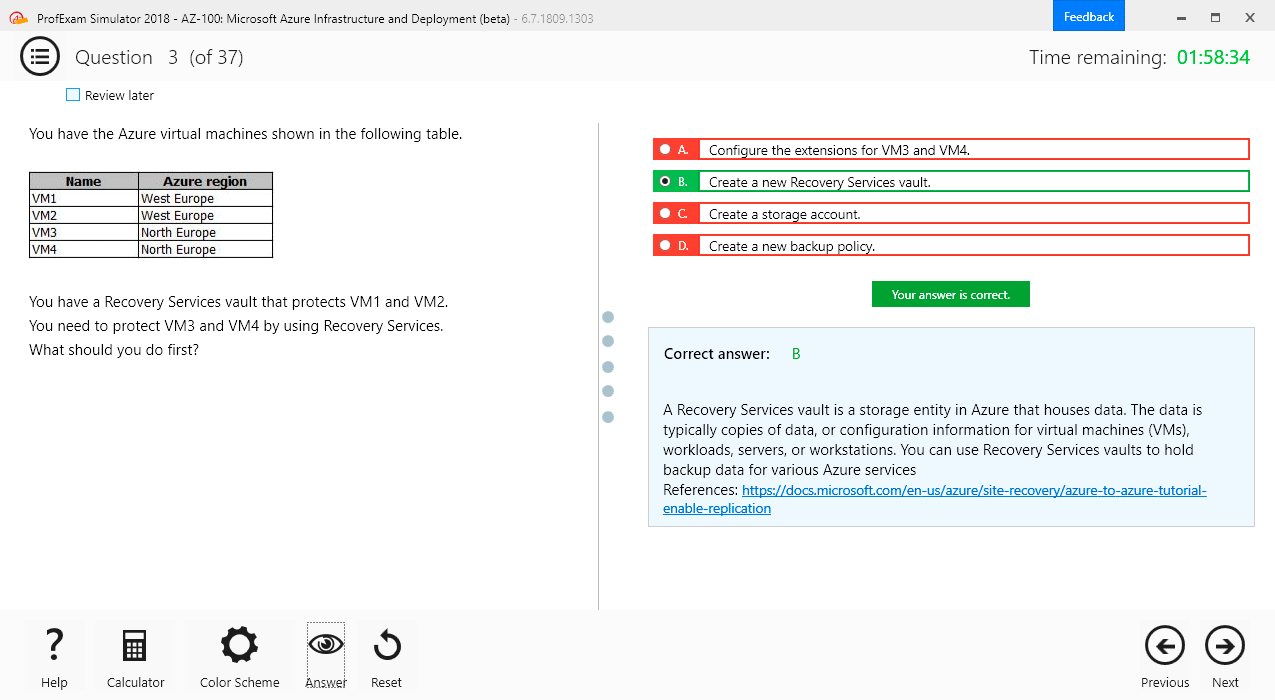
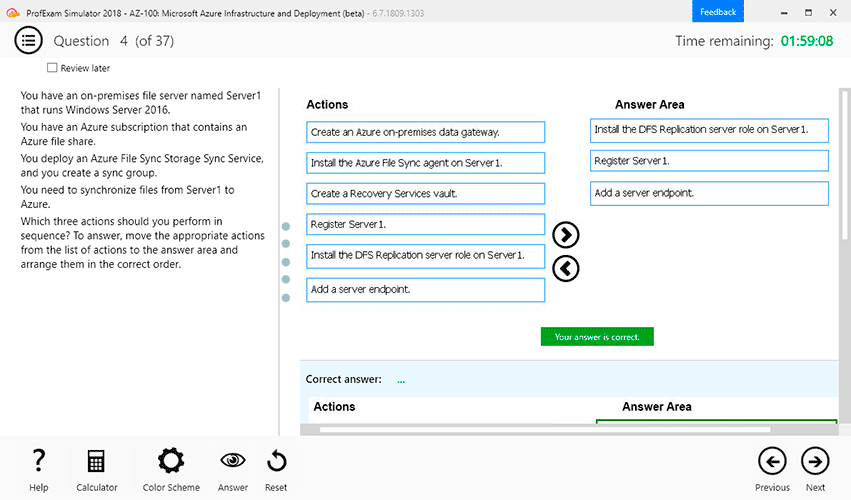
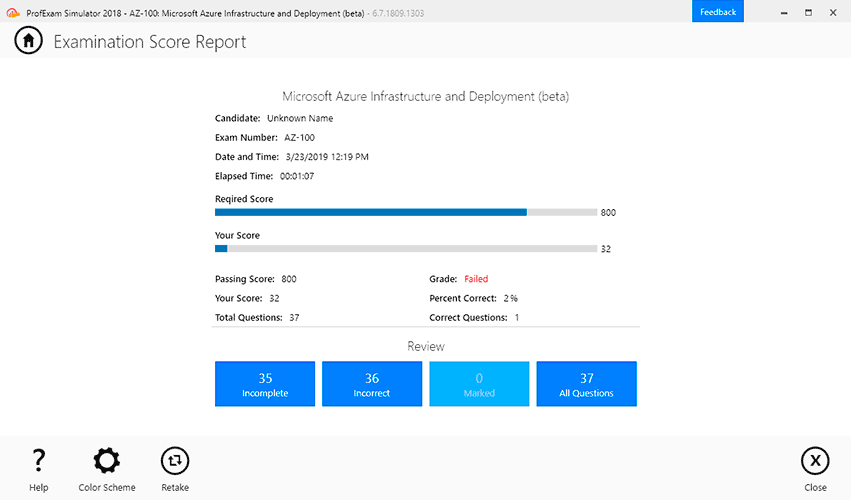
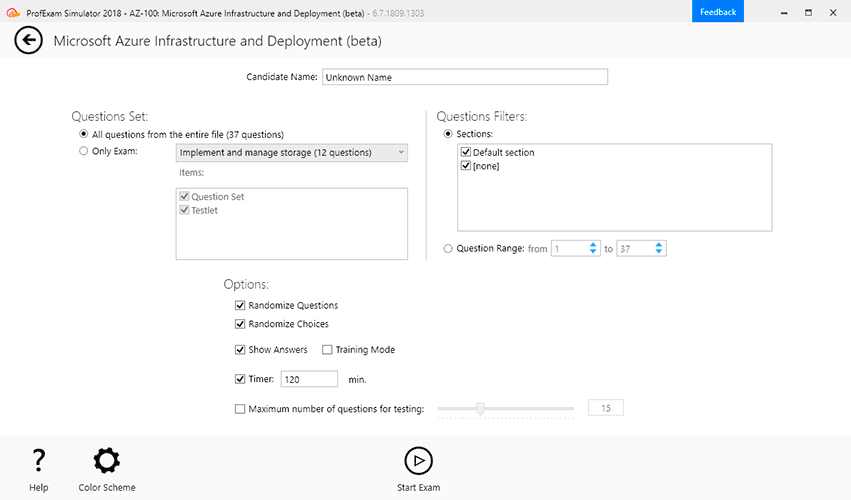

Demo Questions
Question 1
An architect is designing the datastore configuration of a new vSphere-based solution.
The following information was obtained during the initial meeting with the customer:
There is currently 500 production and DMZ virtual machine workloads spread evenly across the primary and secondary site.
The profile of the workloads (per site) is as follows:
- DMZ:
- 75 x Small: 1 vCPU, 2GB RAM, 200GB disk
- Production:
- 50 x Small: 1 vCPU, 2 GB RAM, 200GB disk
- 100 x Medium: 2 vCPU, 4 GB RAM, 200GB disk
- 25 x Large: 4 vCPU, 8 GB RAM, 500GB disk
The average IO Profile per workload is 70/30 read/write.
The solution should cater to 10% storage growth in the first year.
The solution should cater to 15% virtual machine snapshot overhead.
The storage team has confirmed:
- A scalable external storage array has been deployed per site to support the storage requirements.
- The storage array will connect to all hosts using a dedicated Fibre Channel storage area network fabric.
- Usable storage capacity is available in 10TB LUNs.
- As many LUNs as required can be provided.
- Every effort should be made to ensure the number of required LUNs is minimized.
The security team has stated that all DMZ and production workloads must remain logically isolated from each other.
Given the information provided, which three design decisions should the architect make to meet the requirements? (Choose three.)
- Six 10TB VMFS datastores will be configured on each site for all production workloads.
- Four 10TB VMFS datastores will be configured on each site for all production workloads.
- Each 10TB LUN will be configured as a VMFS datastore.
- Two 10TB VMFS datastores will be configured on each site for all DMZ workloads.
- Each 10TB LUN will be configured as an NFS datastore.
- Seven 10TB VMFS datastores will be configured on each site for all workloads.
Correct answer: ACD
Explanation:
Six 10TB VMFS datastores will be configured on each site for all production workloads.This choice is based on the need to distribute production workloads across multiple datastores while ensuring that each datastore is large enough to accommodate the space required by the workloads. Given the average sizes of the virtual machines and the growth and snapshot overhead, six 10TB VMFS datastores would be appropriate for production workloads, ensuring scalability while minimizing the number of LUNs.Each 10TB LUN will be configured as a VMFS datastore.VMFS (Virtual Machine File System) is the standard choice for vSphere environments when using Fibre Channel LUNs. It provides the necessary features, such as concurrency and high-performance access, for production workloads. This option is appropriate given that the storage array uses Fibre Channel for connection and VMFS is the standard file system for such configurations.Two 10TB VMFS datastores will be configured on each site for all DMZ workloads.The DMZ workloads are smaller in number and storage requirements compared to the production workloads, so configuring two 10TB VMFS datastores for DMZ workloads will provide enough capacity while maintaining logical isolation. This approach also minimizes the number of LUNs required to meet the storage growth needs. Six 10TB VMFS datastores will be configured on each site for all production workloads.
This choice is based on the need to distribute production workloads across multiple datastores while ensuring that each datastore is large enough to accommodate the space required by the workloads. Given the average sizes of the virtual machines and the growth and snapshot overhead, six 10TB VMFS datastores would be appropriate for production workloads, ensuring scalability while minimizing the number of LUNs.
Each 10TB LUN will be configured as a VMFS datastore.
VMFS (Virtual Machine File System) is the standard choice for vSphere environments when using Fibre Channel LUNs. It provides the necessary features, such as concurrency and high-performance access, for production workloads. This option is appropriate given that the storage array uses Fibre Channel for connection and VMFS is the standard file system for such configurations.
Two 10TB VMFS datastores will be configured on each site for all DMZ workloads.
The DMZ workloads are smaller in number and storage requirements compared to the production workloads, so configuring two 10TB VMFS datastores for DMZ workloads will provide enough capacity while maintaining logical isolation. This approach also minimizes the number of LUNs required to meet the storage growth needs.
Question 2
An architect is reviewing the security and compliance requirements for a new application that will be hosted on a vSphere 8 environment.
The following information has been noted about the new application:
- The application stores and processes confidential data
- The supporting virtual infrastructure is shared with other departments
- No other application stores or processes confidential data
- The application virtual machines must be able to run on any ESXi host in the cluster
- The storage layer is a iSCSI attached SAN
- Data at Rest Encryption is in place for each presented LUN validated to FIPS 140-2
- No budget is available for additional infrastructure components or software
- Application data must not be accessible outside of the application's virtual machines
The architect has been tasked with providing a secure virtual machine design to host the application.
Which three design elements must the architect include to meet the requirements? (Choose three.)
- Virtual Machine Encryption
- The vSphere Native Key Provider
- A new encrypted iSCSI LUN
- External Key Management Service (KMS) provider
- A new local VMFS volume
- VMware vSAN
Correct answer: ABD
Explanation:
Virtual Machine EncryptionTo ensure that the application's confidential data is protected, Virtual Machine Encryption should be applied. This will ensure that even if someone gains access to the storage layer or the underlying infrastructure, the data in the virtual machine is encrypted and cannot be accessed outside of the VM, as required by the security and compliance requirements.The vSphere Native Key ProviderThe vSphere Native Key Provider can be used to manage encryption keys within the vSphere environment. Since no budget is available for additional infrastructure components or software, leveraging vSphere's native capabilities for key management ensures that encryption is securely handled without introducing external dependencies. This also aligns with the requirement to not introduce additional infrastructure.External Key Management Service (KMS) providerWhile the vSphere Native Key Provider can manage keys within the environment, if there is a requirement for a more secure or compliant key management solution, an External Key Management Service (KMS) may be used.The KMS provider allows for centralized management of encryption keys, ensuring that the keys are securely stored and controlled according to compliance standards (e.g., FIPS 140-2). Although the Native Key Provider may suffice, this option ensures that key management adheres to stricter compliance needs, especially for confidential data. Virtual Machine Encryption
To ensure that the application's confidential data is protected, Virtual Machine Encryption should be applied. This will ensure that even if someone gains access to the storage layer or the underlying infrastructure, the data in the virtual machine is encrypted and cannot be accessed outside of the VM, as required by the security and compliance requirements.
The vSphere Native Key Provider
The vSphere Native Key Provider can be used to manage encryption keys within the vSphere environment. Since no budget is available for additional infrastructure components or software, leveraging vSphere's native capabilities for key management ensures that encryption is securely handled without introducing external dependencies. This also aligns with the requirement to not introduce additional infrastructure.
External Key Management Service (KMS) provider
While the vSphere Native Key Provider can manage keys within the environment, if there is a requirement for a more secure or compliant key management solution, an External Key Management Service (KMS) may be used.
The KMS provider allows for centralized management of encryption keys, ensuring that the keys are securely stored and controlled according to compliance standards (e.g., FIPS 140-2). Although the Native Key Provider may suffice, this option ensures that key management adheres to stricter compliance needs, especially for confidential data.
Question 3
An architect is creating a design for a new vSphere solution to meet the following business requirement:
REQ001 - Reduce operational expenditure
Which design decision could the architect include in the logical design to satisfy this requirement?
- Use vSphere Standard licenses on all clusters.
- Use heterogeneous hardware for the hosts in all clusters.
- Use vSphere Lifecycle Manager on all clusters.
- Use an N + 1 design to define the required capacity on all clusters.
Correct answer: C
Explanation:
vSphere Lifecycle Manager helps reduce operational expenditure (OPEX) by automating the patching and management of the vSphere environment. It provides centralized management for host updates, ensuring consistency across the environment and reducing the manual effort required for ongoing operations. This leads to reduced operational overhead, which directly addresses the requirement to reduce OPEX. vSphere Lifecycle Manager helps reduce operational expenditure (OPEX) by automating the patching and management of the vSphere environment. It provides centralized management for host updates, ensuring consistency across the environment and reducing the manual effort required for ongoing operations. This leads to reduced operational overhead, which directly addresses the requirement to reduce OPEX.
Question 4
As part of designing a greenfield vSphere-based hosting solution, an architect is responsible for defining a patch management solution for the virtual infrastructure.
During initial meetings with the customer, the following information is provided:
- There are two geographically dispersed physical sites (primary and secondary) in scope for the solution.
- The inter-site connectivity has been classified as low bandwidth and high latency.
The customer has the following requirements:
- REQ001 - Only IT Security Team-approved versions of VMware Tools should be installed across all workloads within the infrastructure.
- REQ002 - The solution should minimize traffic across the inter-site link.
- REQ003 - Upgrades to the virtual infrastructure should continue in the event of a failure with either site.
A combination of which three design decisions could the architect make to ensure the requirements are met? (Choose three.)
- The solution will set the UserVars.ToolsRamdisk advanced system setting on each VMware ESXi host to '1' (enabled).
- The solution will ensure that all VMware ESXi hosts within a site have access to the local VMFS datastore containing the shared VMware Tools repository.
- The solution will use VMware Autodeploy to ensure the latest version of VMware Tools is deployed to each workload.
- The solution will set the UserVars.ProductLockerLocation advanced system setting on each VMware ESXi host to point to the local site shared Repository
- The solution will create a shared repository on a VMFS datastore within each site that contains all approved versions of VMware Tools.
- The solution will create a shared repository on a VMFS datastore within the primary site that contains all approved versions of VMwareTools.
Correct answer: BDE
Explanation:
The solution will ensure that all VMware ESXi hosts within a site have access to the local VMFS datastore containing the shared VMware Tools repository.This decision ensures that each site has local access to the VMware Tools repository, which minimizes traffic across the low-bandwidth, high-latency inter-site link. By keeping the repository within each site, the local ESXi hosts can access the repository without needing to traverse the inter-site link frequently.The solution will set the UserVars.ProductLockerLocation advanced system setting on each VMware ESXi host to point to the local site shared repository.This ensures that each ESXi host points to the local site repository for VMware Tools. This approach minimizes inter-site traffic by ensuring that all updates and patches are performed using local resources, avoiding the need to transfer VMware Tools files over the low-bandwidth, high-latency connection.The solution will create a shared repository on a VMFS datastore within each site that contains all approved versions of VMware Tools.This decision ensures that both sites have a local copy of the approved VMware Tools versions, in line with REQ001, which mandates that only IT Security Team-approved versions of VMware Tools should be installed.Additionally, it minimizes inter-site traffic, as both sites will use their local repositories. The solution will ensure that all VMware ESXi hosts within a site have access to the local VMFS datastore containing the shared VMware Tools repository.
This decision ensures that each site has local access to the VMware Tools repository, which minimizes traffic across the low-bandwidth, high-latency inter-site link. By keeping the repository within each site, the local ESXi hosts can access the repository without needing to traverse the inter-site link frequently.
The solution will set the UserVars.ProductLockerLocation advanced system setting on each VMware ESXi host to point to the local site shared repository.
This ensures that each ESXi host points to the local site repository for VMware Tools. This approach minimizes inter-site traffic by ensuring that all updates and patches are performed using local resources, avoiding the need to transfer VMware Tools files over the low-bandwidth, high-latency connection.
The solution will create a shared repository on a VMFS datastore within each site that contains all approved versions of VMware Tools.
This decision ensures that both sites have a local copy of the approved VMware Tools versions, in line with REQ001, which mandates that only IT Security Team-approved versions of VMware Tools should be installed.
Additionally, it minimizes inter-site traffic, as both sites will use their local repositories.
Question 5
An architect is tasked with devising a vSphere design strategy that will allow the company to quickly scale global data center functionality when a new location is identified.
The following requirements must be met:
- The solution must include VMware licensing costs.
- The design must keep data locally to each specific location.
- The design must utilize current company processes around vSphere.
- Any new global location must be functional within one month of identification.
Which design strategy will meet these requirements?
- Plan specific locations throughout the world and build data centers in anticipation of the scale events.
- Purchase new hardware and deploy VMware Cloud Foundation when a new location is identified.
- Select partners in each identified location in anticipation of the scale events.
- Locate a partner that has a data center presence in major global locations that can deploy compatible company architecture.
Correct answer: D
Explanation:
This strategy meets the requirements because:Keeps data locally: By selecting a partner with a global data center presence, data can remain local to each specific location, meeting the geographical data residency requirement.Quick scalability: The partner already has data centers in place, enabling the company to scale quickly and be functional within one month, which meets the timeline requirement.Utilizes current processes: The existing processes around vSphere can still be leveraged since the partner can deploy compatible company architecture that aligns with the company's current infrastructure and processes.VMware licensing costs: VMware licenses would be managed as part of the partnership arrangement, ensuring costs are aligned with the company's existing VMware infrastructure. This strategy meets the requirements because:
Keeps data locally: By selecting a partner with a global data center presence, data can remain local to each specific location, meeting the geographical data residency requirement.
Quick scalability: The partner already has data centers in place, enabling the company to scale quickly and be functional within one month, which meets the timeline requirement.
Utilizes current processes: The existing processes around vSphere can still be leveraged since the partner can deploy compatible company architecture that aligns with the company's current infrastructure and processes.
VMware licensing costs: VMware licenses would be managed as part of the partnership arrangement, ensuring costs are aligned with the company's existing VMware infrastructure.
Question 6
An architect is designing a new vSphere-based solution for a customer.
During a requirement gathering workshop, the following information is provided:
The solution must have a primary and secondary site.
The solution must support a maximum of 1,000 concurrent workloads.
The profile of the workloads are as follows:
- Production Workloads
- 300 x Small: 1 vCPU, 2GB RAM
- 400 x Medium: 2 vCPU, 6GB RAM
- 100 x Large: 4 vCPU, 8GB RAM
- Development Workloads
- 200 x Small: 1 vCPU, 2GB RAM
The corporate security policy states that, during normal operations, production workloads must be physically segregated from development workloads.
All production workloads are split evenly across the primary and secondary site.
All development workloads run only within the secondary site.
In the event of a disaster affecting workloads in the primary site, the secondary site must be capable of running all production and development workloads.
The vCPU to physical core ratio should be a maximum of 10:1 for production workloads and 20:1 for development workloads.
The solution should provide a minimum of N + 1 resiliency at each component level.
The target physical host hardware platform has already been defined by the company's hardware standards and therefore each host has the following configuration:
- 2 x 24 physical cores
- 768GB RAM
- 2 x 100GB SSD drives
- 6 x 10GbE network cards
What is the minimum number of hosts required to meet the requirements?
- 12
- 14
- 8
- 10
Correct answer: A
Explanation:
1. Production Workloads:Total vCPUs required for production:Total production vCPUs = 300 + 800 + 400 = 1,500 vCPUs2. Development Workloads:Total vCPUs required for development:3. Workload Distribution:4. vCPU to Physical Core Ratio:5. Hosts Configuration:6. Host Calculation:Production Workloads (750 vCPUs per site):Development Workloads (200 vCPUs):7. Resiliency:8. Total Hosts:Total hosts required = 4 (primary production) + 4 (secondary production) + 1 (secondary development) + 2 (N + 1) = 12 hosts. 1. Production Workloads:
Total vCPUs required for production:
Total production vCPUs = 300 + 800 + 400 = 1,500 vCPUs
2. Development Workloads:
Total vCPUs required for development:
3. Workload Distribution:
4. vCPU to Physical Core Ratio:
5. Hosts Configuration:
6. Host Calculation:
Production Workloads (750 vCPUs per site):
Development Workloads (200 vCPUs):
7. Resiliency:
8. Total Hosts:
Total hosts required = 4 (primary production) + 4 (secondary production) + 1 (secondary development) + 2 (N + 1) = 12 hosts.
Question 7
An architect is designing a backup solution.
Which two statements should be included in the logical design for this solution? (Choose two.)
- The database must be backed up even/ day during the maintenance window of 1:00AM and 3:00AM.
- The network that will be used for backups will be configured to use VLAN ID 1511.
- The bkp-nfs-01 datastore will be used for backups.
- The company's existing backup solution will be unsupported by the third-party vendor in six months.
- The database will be backed up using an API-based backup solution.
Correct answer: AE
Explanation:
The database must be backed up every day during the maintenance window of 1:00AM and 3:00AM.This is a logical design requirement because it specifies the timing for the backup operations. It's important to define backup schedules to align with the maintenance window, ensuring minimal disruption to production workloads. The database will be backed up using an API-based backup solution.This is a logical design decision that specifies the method of backup. Using an API-based backup solution is a modern, efficient way to ensure consistent and application-aware backups of databases. The database must be backed up every day during the maintenance window of 1:00AM and 3:00AM.
This is a logical design requirement because it specifies the timing for the backup operations. It's important to define backup schedules to align with the maintenance window, ensuring minimal disruption to production workloads.
The database will be backed up using an API-based backup solution.
This is a logical design decision that specifies the method of backup. Using an API-based backup solution is a modern, efficient way to ensure consistent and application-aware backups of databases.
Question 8
Which four factors should an architect consider when calculating the number of hosts required for a new multi-site vSphere-based solution that utilizes external storage? (Choose four.)
- The workload profile (CPU and memory) of each workload
- The amount of resources required for virtual machine (VM) swap and VM snapshots
- The number of existinq workloads that will be decommissioned prior to the completion of project
- The number of existinq workloads that will be miqrated onto the new solution
- The number of network connections per physical host server
- The future physical location of any workloads
- The hardware specification of the underlying infrastructure
Correct answer: ABDG
Explanation:
The workload profile (CPU and memory) of each workloadUnderstanding the CPU and memory requirements for each workload is crucial for determining the capacity needed on each host. This helps ensure that each host has sufficient resources to run the virtual machines (VMs) efficiently.The amount of resources required for virtual machine (VM) swap and VM snapshotsVM swap files and snapshots require additional storage and compute resources. It's important to account for these resource requirements to avoid overloading the hosts or running into resource bottlenecks.The number of existing workloads that will be migrated onto the new solutionKnowing how many workloads will be migrated allows the architect to estimate the total resource demand and determine the number of hosts required to support the migrated workloads effectively.The hardware specification of the underlying infrastructureThe hardware specifications of the hosts, including the CPU, memory, storage, and network interfaces, play a significant role in determining how many hosts are needed to support the workloads. More powerful hardware may reduce the number of hosts required, while less capable hardware might increase the number needed. The workload profile (CPU and memory) of each workload
Understanding the CPU and memory requirements for each workload is crucial for determining the capacity needed on each host. This helps ensure that each host has sufficient resources to run the virtual machines (VMs) efficiently.
The amount of resources required for virtual machine (VM) swap and VM snapshots
VM swap files and snapshots require additional storage and compute resources. It's important to account for these resource requirements to avoid overloading the hosts or running into resource bottlenecks.
The number of existing workloads that will be migrated onto the new solution
Knowing how many workloads will be migrated allows the architect to estimate the total resource demand and determine the number of hosts required to support the migrated workloads effectively.
The hardware specification of the underlying infrastructure
The hardware specifications of the hosts, including the CPU, memory, storage, and network interfaces, play a significant role in determining how many hosts are needed to support the workloads. More powerful hardware may reduce the number of hosts required, while less capable hardware might increase the number needed.
Question 9
An architect is tasked with helping a customer develop a design that meets the following requirements:
- Must have no single point of failure
- Must include thorough standard operating procedure documentation
- Must use VMXNET3 virtual network interface card
- Must have 99.9% uptime Service Level Agreement
- Must use the latest version of VMware vSphere
Which two are considered constraints? (Choose two.)
- Must use the latest version of VMware
- Must have no single point of failure
- Must use VMXNET3 virtual network interface card
- Must include thorough standard operating procedure documentation
- Must have 99.9% uptime Service Level Aqreement
Correct answer: AC
Explanation:
Must use the latest version of VMware vSphereThis is a constraint because the design must adhere to the specific requirement of using the latest version of VMware vSphere. This limits the possible versions or features that can be incorporated into the solution. Must use VMXNET3 virtual network interface cardThis is also a constraint because it mandates the use of a specific virtual network interface card (VMXNET3), restricting the design to that particular choice for network connectivity. Must use the latest version of VMware vSphere
This is a constraint because the design must adhere to the specific requirement of using the latest version of VMware vSphere. This limits the possible versions or features that can be incorporated into the solution.
Must use VMXNET3 virtual network interface card
This is also a constraint because it mandates the use of a specific virtual network interface card (VMXNET3), restricting the design to that particular choice for network connectivity.
Question 10
A company has the requirement to ensure that business-critical applications have the necessary network bandwidth to function optimally and maintain a consistent quality of service (QoS).
Which statement would be included in the conceptual design to support this requirement?
- A distributed switch will be created and Network I/O Control will be enabled.
- The network infrastructure must ensure secure communications and efficiently use available bandwidth.
- Network resource pool named 'bca-pool-02' is given a reservation quota of 5Gbit/sec.
- The distributed switch will use a minimum of 25Gbps Ethernet.
Correct answer: A
Explanation:
This statement supports the requirement for ensuring that business-critical applications have the necessary network bandwidth and maintain consistent quality of service (QoS). By creating a distributed switch and enabling Network I/O Control, you can prioritize network traffic and ensure that the necessary bandwidth is allocated to critical applications, improving their performance and quality of service. This statement supports the requirement for ensuring that business-critical applications have the necessary network bandwidth and maintain consistent quality of service (QoS). By creating a distributed switch and enabling Network I/O Control, you can prioritize network traffic and ensure that the necessary bandwidth is allocated to critical applications, improving their performance and quality of service.

